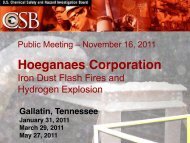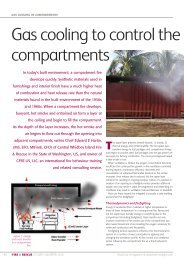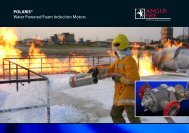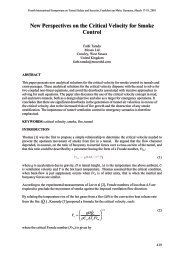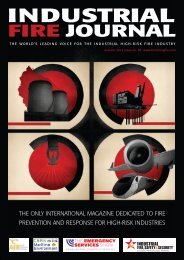Safety and Reliability of Fire Detection Systems in Road Tunnels
Safety and Reliability of Fire Detection Systems in Road Tunnels
Safety and Reliability of Fire Detection Systems in Road Tunnels
Create successful ePaper yourself
Turn your PDF publications into a flip-book with our unique Google optimized e-Paper software.
Fourth International Symposium on Tunnel <strong>Safety</strong> <strong>and</strong> Security, Frankfurt am Ma<strong>in</strong>, Germany, March 17-19, 2010<br />
A more detailed description <strong>of</strong> these systems is given <strong>in</strong> [1]. Table 1 gives an overview on their most<br />
important properties <strong>and</strong> specifications.<br />
SAFETY<br />
<strong>Safety</strong> is used <strong>in</strong> the sense, that all these systems should detect a tunnel fire. A 5 MW fire (typical car<br />
fire) usually should be detected with<strong>in</strong> 60 seconds. The general trend is, to detect the fire <strong>in</strong> a very<br />
early stage <strong>and</strong> prevent a real breakout or fire jump<strong>in</strong>g to more vehicles. This br<strong>in</strong>gs up the question for<br />
a threshold to be used. Today various types <strong>of</strong> test fires are used to qualify fire detection systems.<br />
While the German RABT [2] uses a 5 MW test fire, Austrian RVS 9.282 [4] starts already with a 1.5<br />
MW fire. Hav<strong>in</strong>g <strong>in</strong> m<strong>in</strong>d high w<strong>in</strong>d velocities <strong>of</strong> up to 10 m/s <strong>in</strong> tunnels, this might be crucial for<br />
temperature detection based systems. Table 2 gives the result <strong>of</strong> the comparison <strong>of</strong> different l<strong>in</strong>e type<br />
heat detectors us<strong>in</strong>g different test fires at a w<strong>in</strong>d velocity <strong>of</strong> 3 m/s [5]. It can be recognized that the<br />
semiconductor sensor cable is the fastest one, although all type <strong>of</strong> systems can detect the fires.<br />
Table 2: comparison <strong>of</strong> different l<strong>in</strong>e type heat detectors us<strong>in</strong>g different test fires [5]<br />
# Fuel Area <strong>of</strong> fire LHD 1<br />
copper tube<br />
LHD 2<br />
fibre optic<br />
LHD 4<br />
sensor cable<br />
1 Petrol 2 m 2 28 s 42 s 13 s<br />
2 Petrol 4 m 2 19 s 30 s 11 s<br />
3 Diesel 2 m 2 83 s 60 s 31 s<br />
4 Diesel 4 m 2 30 s 48 s 17 s<br />
5 n-Heptan 1 m 2 165 s 98 s 46 s<br />
6 n-Heptan 2 m 2 37 s 68 s 18 s<br />
7 n-Heptan 4 m 2 25 s 61 s 13 s<br />
Figures 1 <strong>and</strong> 2 show <strong>in</strong> addition a test with a 5 MW fire done at 10 m/s w<strong>in</strong>d velocity <strong>and</strong> a real tunnel<br />
fire <strong>in</strong> a city tunnel. In both cases the detection has been triggered by the rate-<strong>of</strong>-rise. Significant<br />
absolute temperatures are not reached <strong>in</strong> the first case <strong>and</strong> only reached after several m<strong>in</strong>utes <strong>in</strong> the<br />
second case. This means, that rate-<strong>of</strong>-rise detection is m<strong>and</strong>atory <strong>and</strong> systems work<strong>in</strong>g only by absolute<br />
temperature detection as non-resettable cables should not be used <strong>in</strong> the road tunnels.<br />
Figure 1: Test <strong>of</strong> semiconductor sensor cable<br />
with 5 MW fire at 10 m/s<br />
Temperature [°C]<br />
35<br />
30<br />
25<br />
20<br />
15<br />
10<br />
5<br />
Ignition <strong>of</strong><br />
test fire<br />
0<br />
-80 -60 -40 -20 0 20 40 60 80 100 120 140<br />
Time [s]<br />
S1<br />
S2<br />
S3<br />
S4<br />
S5<br />
S6<br />
S7<br />
S8<br />
S9<br />
S10<br />
Figure 2: City tunnel fire detected by<br />
semiconductor sensor cable<br />
Temperature [°C]<br />
120<br />
100<br />
80<br />
60<br />
40<br />
20<br />
0<br />
-600 -400 -200 0 200 400 600 800<br />
time [s]<br />
Sensor 12<br />
Sensor 13<br />
Sensor 14<br />
Sensor 15<br />
Sensor 16<br />
Another safety issue is the human <strong>in</strong>terface. Here we can see very different philosophies between a<br />
strictly automatic system go<strong>in</strong>g directly from detection (possibly by several <strong>in</strong>dependent systems) to<br />
alarm <strong>and</strong> control room dom<strong>in</strong>ated systems, where all alarms have to be confirmed before go<strong>in</strong>g to the<br />
different alarm reaction mechanisms. But <strong>in</strong> most tunnel applications a mixture can be found. Whereas<br />
temperature detection is usually trigger<strong>in</strong>g the fire scenario directly <strong>and</strong> has to be <strong>in</strong>terrupted by manual<br />
562



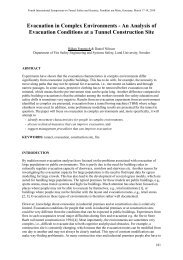

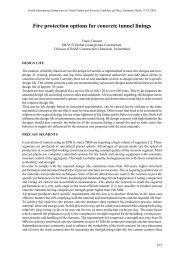
![30-37 TunnelsREV[1]rev.qxd - Industrial Fire Journal](https://img.yumpu.com/22237435/1/184x260/30-37-tunnelsrev1revqxd-industrial-fire-journal.jpg?quality=85)
